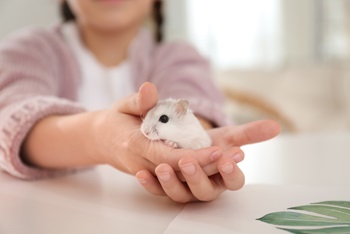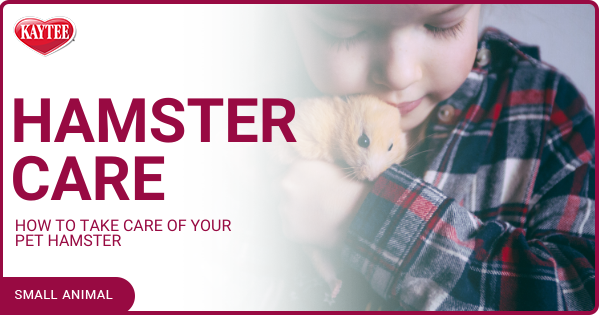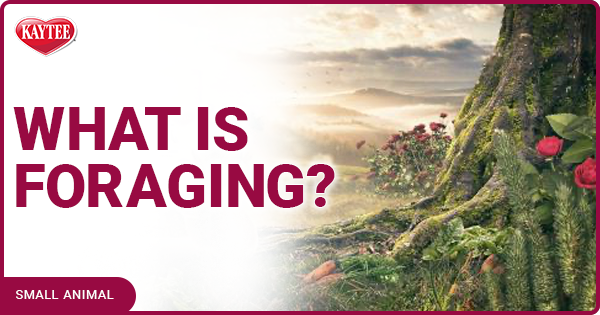How To Take Care Of A Hamster
Here are the basics every hamster owner should know, from small animal housing and accessories to hamster food, treats, and playtime.
Habitats For Hamsters Explained
The best habitats for hamsters feature latching doors, closed tops, and narrow width wire walls to keep them safely contained. If you've nicknamed your hamster Houdini, you're not the only one! These furry friends are known for being clever escape artists.
In addition to keep your hamster safe, look for these features in a cage:
• Tunnels for exploring
• Ramps for climbing
• Wheels or balls for exercise
• Shelves for roaming
Inside the hamster habitat, you'll want to add a water bottle, food bowl, absorbent bedding, and accessories to keep the pet entertained and cozy. Some of the most popular hamster habitat accessories include the colorful Kaytee Igloo Hideout, natural Kaytee Play 'n Chew Cubby Nest and soft Kaytee Super Sleeper Cuddle-E-Cup.

Hammys have tons of energy and need daily self-guided play that will get their little legs moving. A large running wheel, ladders to climb, and soft bedding are all great options to support the pet's exercise needs.
Healthy Hamster Feeding Tips
When it comes to mealtime, hamsters are curious omnivores that require a diet with ample protein and variety for good nutrition. They use their tiny paws to dig into a pellet food mix made of all the things they would naturally forage in the wild, including protein-rich grains, seeds, and nuts, plus a variety of dried flowers, fruits, and vegetables.Kaytee Food From The Wild Hamster food offers all those yummy ingredients to align with a hamster's innate feeding needs and desires passed down from generations. The mix also includes probiotics, antioxidants, amino acids, Omega-3s, and prebiotics to keep your pet healthy.
Fun fact: Unlike other small animals, like guinea pigs, rabbits, and chinchillas, hamsters don't need Timothy Hay in flake or pellet form to stay healthy.
To avoid obesity in your hamster, avoid offering an all-seed diet. Sure the hammy might crave sunflower seeds and pumpkin seeds, but a balanced diet keeps your pet healthy. And, feeding your hamster a pellet diet as the main course will help you reach that goal. To ensure your pet doesn't overeat, follow the hamster food package instructions for daily portion recommendations.
When it comes to beverages, water is number one for hamsters. To avoid bacteria growth and keep the water fresh, dump and rinse the water bottle every day before adding new water.
Note: Sanitize the water bottle once a week, as well as the food bowl, habitat base tray, and plastic accessories by washing with a mild bleach water solution followed by a thorough rinsing with clear water.
Treats for Pet Hamsters
The best treats for pet hamsters are rigid, like wooden sticks, enabling the pet to file down their perpetually growing teeth naturally. Leave these hamster treats in the cage for 24/7 munching. Hamsters love to chew and nibble!
In moderation, your pet can also enjoy low-sugar fresh vegetables like carrots, broccoli, cauliflower, cucumber, and spinach. Be sure the produce is raw and not seasoned or buttered. Offer a tablespoon or so of a fresh treat once every few days. You'll know you've offered too much if your pet gets diarrhea.
Bonding With Your Hamster
These palm-sized pets love to play! The best way to engage with a hamster and grow your bond is through activities that encourage them to use both their brain and brawn.
Create an obstacle course where the hammy can climb, tunnel, problem-solve, and earn treats. Set up various hamster toys inside a Kaytee Crittertrail Playpen With Mat, then cheer on the pet as they move through the activities.
.jpg?h=234&w=350&hash=7376622C4822D9067C4066E89E4999BD)
Hamsters also love to explore your home by zipping around in a Kaytee Run-About Ball. Watch your pet roll forward, bump into things, make turns, and satiate that curious little mind. For a low-stress experience for the hamster, only let the pet run in areas where larger animals (like cats and dogs) are not present.
You'll know your hammy is ready to rest when he curls up into ball or gets crabby. Hamsters may get nippy and can vocalize their disgust! Is their way of asking to go back into their cozy habitat for a nap, snack, or drink of water. Honor these messages, and you'll have a happy pet.
Now that you've learned the basics on how to house, feed, and handle your pet hamster, learn even more about choosing the right bedding and litter, selecting small animal treats, and if you have children, teaching little ones how to care for small pets including hamsters. You got this, hammy parent!
Sources:
VCA Animal Hospitals - Owning a Pet Hamster
University of California, Davis Veterinary Medicine - Hamster Care
Vet Care Pet Hospital - Beginners Guide: Hamster Care

